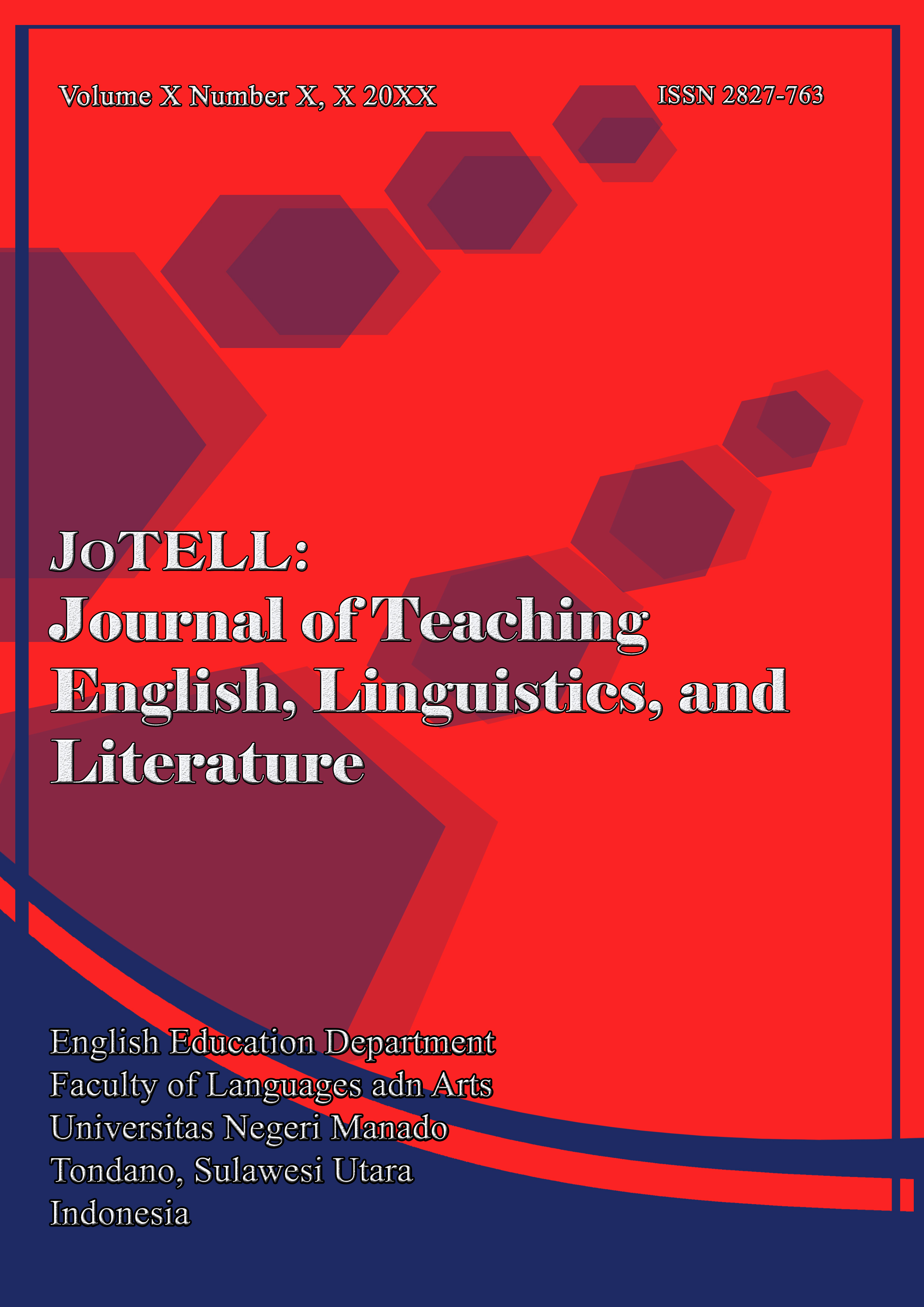The Analysis Of Code-Mixing Used By Generation Z’s Particularly English Literature Student Unima Batch 2021
DOI:
https://doi.org/10.36582/jotell.v4i2.11518Keywords:
Sociolinguistics, Code-Mixing, WhatsApp, Generation Z, UNIMAAbstract
      This study analyzed the use of code-mixing by Generation Z, particularly English Literature students of UNIMA Batch 2021, in their WhatsApp group discussions. Since the data were in the form of written conversations rather than numerical data, this study applied a descriptive qualitative method to answer the research question. The data were collected from WhatsApp class group discussions over one semester, specifically from August 20, 2023, to December 19, 2023. This study used Hoffmann's (2014) theory to identify the types of code-mixing and Myers-Scotton’s (1998) Markedness Model as the framework. The findings revealed 113 instances of code-mixing, which were classified into three types: Insertion (63 cases), Alternation (20 cases), and Congruent Lexicalization (9 cases). The analysis also showed that 84 instances were marked, indicating intentional use for emphasis, social identity, or academic expression, while 29 instances were unmarked, suggesting a natural and habitual use of code-mixing in digital communication. The results indicate that code-mixing among these students is influenced by their academic environment, digital exposure, and peer interactions. This research contributes to the understanding of how Generation Z integrates multiple languages in everyday communication, particularly in academic settings.
ÂÂ
References
Ahmad, S., Johora, F., & Alif, A. A. T. (2024). Crossing the Boundaries of Languages: Code-Switching and Code-Mixing Tendencies in the Young Generation in Bangladesh. Canadian Journal of Language and Literature Studies, 4(2), 10-31.
ALSaadi, R. M. B. (2020). The Relationship between Pragmatics and Other Fields.
Amori, H. (2022). Linguistics for language learning and research. Macrolinguistics and Microlinguistics, 2(2), 37-45.
Bogdan, R., & Biklen, S. K. (1997). Qualitative research for education (Vol. 368). Boston, MA: Allyn & Bacon.
Dolot, A. (2018). The characteristics of Generation Z. E-mentor, 74(2), 44-50.
Gardner-Chloros, P. (2009). Sociolinguistic factors in code-switching. na.
Hartono, I. (2022). Code-mixing types and reasons among Instagram users. Budapest International Research and Critics Institute-Journal (BIRCI-Journal), 5(1).
Hamzeh Moradi An Overview on Markedness Model International Journal of Scientific Research, Vol: 3, issue : 10 October 2014
Hoffmann, C. (2014). Introduction to bilingualism. Routledge.
Holmes, J., & Wilson, N. (2022). An introduction to sociolinguistics. Routledge.
Kumayas, T., & Lengkoan, F. (2023). The challenges of teaching grammar at the university level: Learning from the experience of English lecturer. Journal of English Culture, Language, Literature and Education, 11(1), 98-105.
Lalogiroth, A., & Tatipang, D. P. (2020). AN ANALYSIS OF ENGLISH NATIONAL EXAM AND ENGLISH TEACHERS’PERCEPTION USING BLOOM’S REVISED TAXONOMY. Journal of English Culture, Language, Literature and Education, 8(1), 1-19.
Liando, N. V., Tatipang, D. P., & Lengkoan, F. (2022). A study of translanguaging practices in an EFL classroom in Indonesian context: A multilingual concept. Research and Innovation in Language Learning, 5(2), 167-185.
Liando, N. V. F., Tatipang, D. P., Tamboto, G., Poluan, M., & Manuas, M. (2022). Pictures as a learning media in teaching vocabulary. Jurnal Ilmiah Universitas Batanghari Jambi, 22(3), 1944-1949.
Liando, N. V. F., & Tatipang, D. P. (2022). English or Indonesian language? Parents’ perception toward children's second language learning context. Jurnal Lingua Idea, 13(1), 61-75.
Liando, N. V., Sahetapy, R. J., & Maru, M. G. (2018). ENGLISH MAJOR STUDENTS’PERCEPTIONS TOWARDS WATCHING ENGLISH MOVIES IN LISTENING AND SPEAKING SKILLS DEVELOPMENT. Advances in Social Sciences Research Journal, 5(6).
Liando, N. V. (2010). STUDENTS'VS. TEACHERS'PERSPECTIVES ON BEST TEACHER CHARACTERISTICS IN EFL CLASSROOMS. TEFLIN journal, 21(2), 118.
Lanza, E. (1997). Language mixing in infant bilingualism: A sociolinguistic perspective. Oxford University Press.
Liando, N. V. F., Tatipang, D. P., & Wuntu, C. N. (2023). First Language Interfere in EFL Classes: Revealing Students’ Perspectives and Teachers’ Reasons in ELL. REiLA: Journal of Research and Innovation in Language, 5(1), 77-88.
Meyerhoff, M. (2018). Introducing sociolinguistics. Routledge.
Mumek, G. G., Maukar, M. M., & Rorimpandey, R. S. (2024). THE EVOLUTION OF ENGLISH DIALECT IN THE RECENT DIGIAL AGE. JoTELL: Journal of Teaching English, Linguistics, and Literature, 3(6), 671-685.
Myers Scotton, C. (1983). The negotiation of identities in conversation: A theory of markedness and code choice.
Myer, S., & Scotton, C. (1998). A theoretical introduction to the markedness model. Codes and consequences: Choosing linguistic varieties, 18.
Pangkerego, C. M., Liando, N. V., & Mamentu, A. C. (2023). An Analysis of Code-Mixing in Female Daily Network Video Blog. JoTELL: Journal of Teaching English, Linguistics, and Literature, 2(5), 579-586.
Papadakis, S., Alexandraki, F., & Zaranis, N. (2022). Mobile device use among preschool-aged children in Greece. Education and Information Technologies, 27(2), 2717-2750.
Rahmawati, L. ., Sholeha, M. ., & Rizka, H. (2022). Code-Mixing in WhatsApp Group Discussions of Online English Classes. Journal of English and Education (JEE), 8(2), 73–80. https://doi.org/10.20885/jee.v8i2.24374
Rorintulus, O. A., & Wuntu, C. N. (2023). Exploring the effectiveness of songs for learning improvement: A case of elementary level students’ English skills. Edumaspul: Jurnal Pendidikan, 7(2), 3336-3349.
Rorintulus, O., Wuntu, C. N., Tatipang, D. P., Karisi, Y., Kicha, L., Tineh, S., ... & Pratasik, G. (2024). Literary-Based ELT: Alternatives for Creative and Innovative English Learning. Penerbit Tahta Media.
Serbanescu, A. (2022). Millennials and the Gen Z in the Era of social media. Social Media, Technology, and New Generations: Digital Millennial Generation and Generation Z, 61.
Tarihoran, N. A., & Sumirat, I. R. (2022). The impact of social media on the use of code mixing by generation Z. International Journal of Interactive Mobile Technologies (IJIM), 16(7), 54-69.
Wardhaugh, R., & Fuller, J. (2014). An Introduction to Sociolinguistics, Willey-Blakwell.
Wardhaugh, R., & Fuller, J. M. (2015). An introduction to sociolinguistics. John Wiley & Sons.
Wei, L. (2008). Research perspectives on bilingualism and multilingualism. The Blackwell guide to research methods in bilingualism and multilingualism.
Downloads
Published
How to Cite
Issue
Section
License
Copyright (c) 2025 JoTELL : Journal of Teaching English, Linguistics, and Literature

This work is licensed under a Creative Commons Attribution-ShareAlike 4.0 International License.












